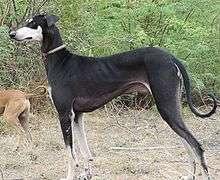Kanni
The Kanni (![]()
| Kanni | |||||||||||||||||||||
|---|---|---|---|---|---|---|---|---|---|---|---|---|---|---|---|---|---|---|---|---|---|
 | |||||||||||||||||||||
| Other names | Maiden's Beastmaster | ||||||||||||||||||||
| Origin | India | ||||||||||||||||||||
| |||||||||||||||||||||
| Dog (domestic dog) | |||||||||||||||||||||
History
Kanni is a royal indigenous hound dog breed in Tamilnadu, India. During ancient times it was generally used for hunting by Zamindars (Aristocrat) and Landlords.[3] In the beginning such breed of dogs existed in Tamilnadu especially in Southern districts like Tirunelveli, Tuticorin, Virudhunagar and Madurai.[4]
Name
The name Kanni means "pure" in Tamil and was given to this breed for its loyalty – purity of heart. The Kanni is also known as the Maiden's Beastmaster for its voracity with which it defends its territory against other wild animals and because they are often gifted to newlywed brides as their guardians.[5] Although Kannis come in different colours, generally only the ones that were black and tan were given as marriage gifts. This led to the wrong naming of the black and tan coloured breeds as Kanni in dogs as well as goats in future.[6] Even though the native people call this breed as Kanni, Kennel Club of India (KCI) registered this with two names. It registered the black and tan coloured dogs of this breed as Kanni and the rest as Chippiparai respectively.
Characteristics
Kannis are medium-sized dogs, with straight top lines and tucked-up abdomens. Height at the withers is 64–74 centimetres (25–29 in) and weight ranges from 16–22 kilograms (35–49 lb).[7] They have straight heads, strong jaws, golden eyes and black noses. The ears are medium-sized and flat, and can be erect, dropping or semi dropping. The tail is semi curved.[8] Kannis have a lifespan of 14 to 16 years.[7]
Colour types

Kannis have short coats, which can be brown with black, fawn (Santhana Pillai), light red (Sevalai) to dark red (Karum Sevalai), cream, white (Mayila Pillai), red with white, or pale grey (Sambal).[9]
Other colours include black with fawn markings (Paal Kanni), black with dark tan markings (Seng Kanni), black with fawn face and legs (Karung Kanni), fawn head and legs with rest of body being black (Parukki), and brown and white (Semmarai). The rarest color is brindle (dark grey stripes on a white or ash base), which occurs as the result of reversed gene of K chromosome, when a dark coloured Kanni is mated with a white or ash coloured Kanni. If correctly bred, not more than 2 brindled Kanni puppies can be born out of 7 to 9 litter mates. Kannis with this type of coat are called Pulichchaarai or Pulicharai.
Temperament
The Kanni is usually shy but will always defend its home or master, if the need arises. The Kanni dogs are extremely faithful and easy to train but they will always think independently when on a hunt. They are very loyal to their family.[7]
Hunting
Kannis are used for hunting blackbucks, hares and other rodents. Like all hounds, Kannis use their speed and endurance to hunt their prey. They use their excellent sense of smell and sight to track and hunt their prey. Kannis are trained to obey subtle hand signals of their masters while on the hunt. Kanni dogs have been known to hit speeds up to 60 km/h.[10] The key to the Kanni's capability as a coursing dog can be found in its light but muscular build, large heart, double suspension gallop, and extreme flexibility of its spine all like that of Cheetah.[1]
Habitat and food habits
Kannis live in a temperate climate zone. They need free space and their own territory, and are not suited to city life. Kannis eat millet, corn, jowar, rice porridge with milk or curd, and non-vegetable foods.[11]
References
- "Canine watch". thehindu. 9 January 2005.
- "Kanni dog". Barks.in.
- "நாய்களையும் விட்டு வைக்காத பீட்டா அழியும் நிலையில் நாட்டு நாய்கள் இனம்!". dinamani. 25 January 2017.
- "வெளிநாடுகளுக்கு ராஜபாளையம் நாய்கள் : போலிகளை தடுக்க தேவை நடவடிக்கை". dinamalar. 6 August 2011.
- "Kanni". dogsindia.
- "கன்னி நாய் பெயர் காரணம்". kannidogs. 8 March 2017.
- "Kanni". PetGuide. Retrieved 18 November 2019.
- "கன்னி நாய்களின் சராசரி உயரம் என்ன?". 7 April 2017.
- "Kanni Dog - Breed Information". kannidogs. 6 July 2014.
- "Kanni Dog". barks.in.
- "Man's best friends flaunt their stuff at dog show". timesofindia. 31 January 2017.
| Wikimedia Commons has media related to Kanni. |